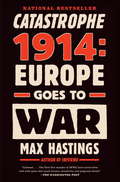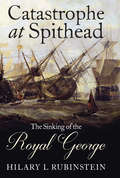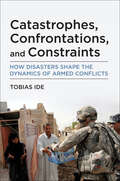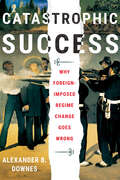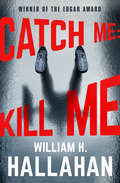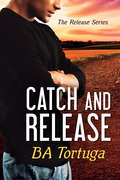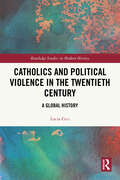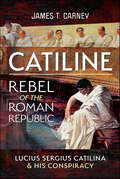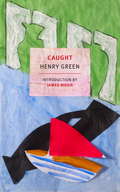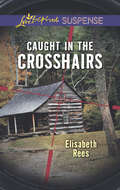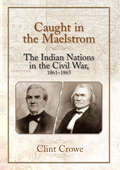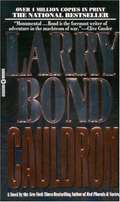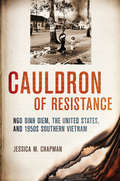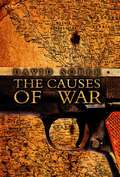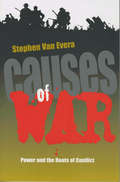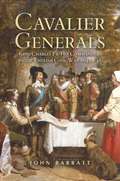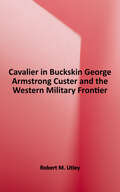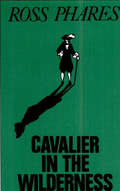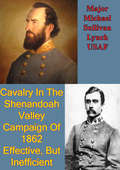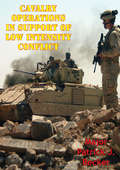- Table View
- List View
Catastrophe 1914: Europe Goes to War
by Max HastingsFrom the acclaimed military historian, a new history of the outbreak of World War I: the dramatic stretch from the breakdown of diplomacy to the battles--the Marne, Ypres, Tannenberg--that marked the frenzied first year before the war bogged down in the trenches. In Catastrophe 1914, Max Hastings gives us a conflict different from the familiar one of barbed wire, mud and futility. He traces the path to war, making clear why Germany and Austria-Hungary were primarily to blame, and describes the gripping first clashes in the West, where the French army marched into action in uniforms of red and blue with flags flying and bands playing. In August, four days after the French suffered 27,000 men dead in a single day, the British fought an extraordinary holding action against oncoming Germans, one of the last of its kind in history. In October, at terrible cost the British held the allied line against massive German assaults in the first battle of Ypres. Hastings also re-creates the lesser-known battles on the Eastern Front, brutal struggles in Serbia, East Prussia and Galicia, where the Germans, Austrians, Russians and Serbs inflicted three million casualties upon one another by Christmas. As he has done in his celebrated, award-winning works on World War II, Hastings gives us frank assessments of generals and political leaders and masterly analyses of the political currents that led the continent to war. He argues passionately against the contention that the war was not worth the cost, maintaining that Germany's defeat was vital to the freedom of Europe. Throughout we encounter statesmen, generals, peasants, housewives and private soldiers of seven nations in Hastings's accustomed blend of top-down and bottom-up accounts: generals dismounting to lead troops in bayonet charges over 1,500 feet of open ground; farmers who at first decried the requisition of their horses; infantry men engaged in a haggard retreat, sleeping four hours a night in their haste. This is a vivid new portrait of how a continent became embroiled in war and what befell millions of men and women in a conflict that would change everything.
Catastrophe at Spithead: The Sinking of the Royal George
by Hilary L. RubinsteinThis fascinating historical inquiry sheds new light on the mysterious sinking of an 18th century warship and its lingering effect on British naval culture.On August 29th, 1782, the mighty flagship HMS Royal George suddenly capsized while anchored in the calm, familiar waters of Spithead on the English Channel. In one of the most sensational and perplexing incidents in naval history, Rear Admiral Richard Kempenfelt, an outstanding veteran officer, drowned along with more than 800 crew and many civilian visitors.Catastrophe at Spithead is the first comprehensive account of the sinking, drawn from a variety of archival sources, including reports by survivors and eyewitnesses. Hilary L. Rubinstein examines the mysterious cause and tragic cost of the disaster, as well as its lingering aftereffects, including its treatment in literature. As well as describing the sinking, Rubenstein uncovers new information on the life and career of Rear Admiral Kempenfelt, ranging from his familial relation to the great Admiral Rodney to accounts of his whereabouts when the ship sank. These call into question the scenario in William Cowper's famous poem, “On the Sinking of the Royal George,” which depicts Kempenfelt writing in his cabin when she foundered.
Catastrophes, Confrontations, and Constraints: How Disasters Shape the Dynamics of Armed Conflicts
by Tobias IdeA ground-breaking study on how natural disasters can escalate or defuse wars, insurgencies, and other strife.Armed conflict and natural disasters have plagued the twenty-first century. Not since the end of World War II has the number of armed conflicts been higher. At the same time, natural disasters have increased in frequency and intensity over the past two decades, their impacts worsened by climate change, urbanization, and persistent social and economic inequalities. Providing the first comprehensive analysis of the interplay between natural disasters and armed conflict, Catastrophes, Confrontations, and Constraints explores the extent to which disasters facilitate the escalation or abatement of armed conflicts—as well as the ways and contexts in which combatants exploit these catastrophes.Tobias Ide utilizes both qualitative insights and quantitative data to explain the link between disasters and the (de-)escalation of armed conflict and presents over thirty case studies of earthquakes, droughts, floods, and storms in Africa, the Middle East, Asia, and Latin America. He also examines the impact of COVID-19 on armed conflicts in Iraq, Afghanistan, Nigeria, and the Philippines.Catastrophes, Confrontations, and Constraints is an invaluable addition to current debates on climate change, environmental stress, and security. Professionals and students will greatly appreciate the wealth of timely data it provides for their own investigations.
Catastrophic Success: Why Foreign-Imposed Regime Change Goes Wrong (Cornell Studies in Security Affairs)
by Alexander B. DownesIn Catastrophic Success, Alexander B. Downes compiles all instances of regime change around the world over the past two centuries. Drawing on this impressive data set, Downes shows that regime change increases the likelihood of civil war and violent leader removal in target states and fails to reduce the probability of conflict between intervening states and their targets. As Downes demonstrates, when a state confronts an obstinate or dangerous adversary, the lure of toppling its government and establishing a friendly administration is strong. The historical record, however, shows that foreign-imposed regime change is, in the long term, neither cheap, easy, nor consistently successful. The strategic impulse to forcibly oust antagonistic or non-compliant regimes overlooks two key facts. First, the act of overthrowing a foreign government sometimes causes its military to disintegrate, sending thousands of armed men into the countryside where they often wage an insurgency against the intervener. Second, externally-imposed leaders face a domestic audience in addition to an external one, and the two typically want different things. These divergent preferences place imposed leaders in a quandary: taking actions that please one invariably alienates the other. Regime change thus drives a wedge between external patrons and their domestic protégés or between protégés and their people. Catastrophic Success provides sober counsel for leaders and diplomats. Regime change may appear an expeditious solution, but states are usually better off relying on other tools of influence, such as diplomacy. Regime change, Downes urges, should be reserved for exceptional cases. Interveners must recognize that, absent a rare set of promising preconditions, regime change often instigates a new period of uncertainty and conflict that impedes their interests from being realized.
Catch Me: Kill Me
by William H. HallahanEdgar Award Winner for Best Mystery Novel: “Takes off like a Chinook and whisks you through a labyrinth non-stop until the final sentence” (Clive Cussler). Russian poet Boris Kotlikoff defected to the United States two years ago. He left with no state secrets; he is no threat to the Soviets in anyway; yet now he has become their prize hostage, buried alive somewhere in New York City. The US government, on the defensive as always, treads on cat feet. But it does not take into consideration the doggedness of Ben Leary, an agent with Immigration and Naturalization. They also close their eyes to a parallel search by Gus Geller, a hatchet man for the CIA. And the government isn’t even aware of Charlie Brewer, a discredited ex-CIA agent Geller puts in charge of the actual search. Will the vicious infighting among these three in a struggle against time and missed opportunities set up Kotlikoff as a doomed pawn? “Compelling . . . A kind of catch-22.” —Time
Catch and Release (The Release Series #3)
by Ba TortugaThe Release Series: Book ThreeDakota Landry just got out of prison after twelve years. If anyone can understand how that feels, it's his new friend, Sage, who is determined to help him get used to life on the outside--and believes Dakota didn't commit the crime he was in for. Jayden Wilson is a former prosecutor who agrees to look into the case at the request of Sage's lover, Adam. He sets out to prove Dakota is just another "innocent" ex-con, but once they meet, Jayden is more and more convinced Dakota just didn't do what everyone thinks he did. Trouble follows Dakota, and nothing is easy as he struggles to figure out how to live, now that he has choices. And Jayden isn't sure how Dakota, or any lover for that matter, fits into his life. Their path from friendship to romance is a slow one, but Dakota begins to believe he deserves a chance at life, and Jayden falls a little more for Dakota every day. Now they just need to tell each other how they feel.
Catch-22
by Joseph Heller"Catch-22" is one of this century's greatest works of American literature. First published in 1961, Joseph Heller's profound and compelling novel has appeared on nearly every list of must read fiction. It is a classic in every sense of the word. "Catch-22" took the war novel genre to a new level, shocking us with its clever and disturbing style. Set in a World War II American bomber squadron off the coast of Italy, "Catch-22" is the story of John Yossarian, who is furious because thousands of people he has never met are trying to kill him. Yossarian is also trying to decode the meaning of Catch-22, a mysterious regulation that proves that insane people are really the sanest, while the supposedly sensible people are the true madmen. And this novel is full of madmen -- Colonel Cathcart, who keeps raising the number of missions the men must fly in order to finish their tour; Milo Minderbinder, a dedicated entrepreneur who bombs his own airfield when the Germans offer him an extra 6 percent; Major Major Major, whose tragedy in life is that he resembles Henry Fonda; and Major -- de Coverley, whose face is so forbidding no one has dared ask his name. No novel before or since has matched "Catch-22's" intensity and brilliance in depicting the brutal insanity of war. Heller satirizes military bureaucracy with bitter, stinging humor, all the while telling the darkly comic story of Yossarian, a bombardier who refuses to die. Nearly forty years later, Yossarian lives.
Catching the Tide: A stunning epic novel of secrets, betrayal and passion
by Judith LennoxSecrets shape the ebb and flow of our lives... Two sisters face battles in life and love amongst the ever-present threat of war in Judith Lennox's unforgettable historical novel, Catching the Tide. Perfect for fans of Santa Montefiore and Kate Morton.1933. Tessa and Frederica Nicolson enjoy one last idyllic summer at the beautiful Villa Millefiore, overlooking Florence. Four years later, Italy is a distant memory and Tessa is revelling in the glamour and excitement of modelling in London, until a passionate affair with married author Milo Rycroft leads to tragic consequences. Tessa returns to Florence, and, missing her sister desperately, Freddie, too, travels to Italy, where she is swept up in adventure, danger and romance, and makes a chance encounter that will change her life. With the outbreak of World War Two, Tessa and Freddie must fight for their own survival and happiness, while they wonder whether they will ever see each other again...(P)2011 Isis Audio
Cathar Castles
by Peter Dennis Marcus CowperIn the early 12th century AD a large area of present-day France was not under the direct control of the French king. In fact, the French king's direct authority stretched little further than Paris and the area immediately around it, the Ile de France. Many of the other regions were semi-independent duchies and counties, controlled by, amongst others, the King of England and the Holy Roman Emperor. One such area free from direct French control was the Languedoc, the area stretching from the Massif Central south to the Pyrenees, and as far as the river Rhone to the east. This area was under the loose overlordship of the counts of Toulouse, and by the beginning of the 12th century the whole region had become the centre of an early form of Protestantism called Catharism that flourished to an extraordinary degree and threatened the rule of the Roman Catholic Church. Pope Innocent III, alarmed at this heresy and the unwillingness of the southern nobility to do much to uproot it, launched a crusade in 1209 against European Christians. The crusading army, represented the established Church consisting predominatly of northern French knights. They saw this as an opportunity both to 'take the cross' and to obtain new lands and wealth for themselves more conveniently than crusading to the Holy land. This, the Albigensian Crusade, became a brutal struggle between the north and the south of France as much as between orthodox Roman Catholic and heretic Cathar. The inhabitants of the Languedoc had always relied for their safety upon a series of strongly fortified walled cities, such as Albi, Carcassonne, B�ziers, Toulouse and a large number of fortified hill-top villages and castles which dotted the countryside. These so-called 'Cathar Castles' now became the last refuge against the invading crusaders and the conflict developed into a series of protracted and bloody sieges that lasted for over 30 years. The author describes these two very different types of fortification, the walled city and the hill-top castle. He explains why they were positioned where they were, how they were built, and the defensive principles behind their construction, and also reviews how well they withstood the test of the Albigensian Crusade.Related TitlesThe Crusades (Essential Histories)Medieval Siege Warfare (Elite)French Medieval Armies 1000-1300 (Men-at-Arms)
Catherine the Great and Potemkin: The Imperial Love Affair
by Simon Sebag Montefiore'One of the great love stories of history, in a league with Napoleon and Josephine, and Antony and Cleopatra ... Excellent, with dazzling mastery of detail and literary flair' EconomistIt was history's most successful political partnership - as sensual and fiery as it was creative and visionary. Catherine the Great was a woman of notorious passion and imperial ambition. Prince Potemkin - wildly flamboyant and sublimely talented - was the love of her life and her co-ruler.Together they seized Ukraine and Crimea, defining the Russian empire to this day. Their affair was so tumultuous that they negotiated an arrangement to share power, leaving Potemkin free to love his beautiful nieces, and Catherine her young male favourites. But these 'twin souls' never stopped loving each other.Drawing on their intimate letters and vast research, Simon Sebag Montefiore's enthralling, widely acclaimed biography restores these imperial partners to their rightful place as titans of their age.
Catherine the Great and Potemkin: The Imperial Love Affair
by Simon Sebag Montefiore'One of the great love stories of history, in a league with Napoleon and Josephine, and Antony and Cleopatra ... Excellent, with dazzling mastery of detail and literary flair' EconomistIt was history's most successful political partnership - as sensual and fiery as it was creative and visionary. Catherine the Great was a woman of notorious passion and imperial ambition. Prince Potemkin - wildly flamboyant and sublimely talented - was the love of her life and her co-ruler.Together they seized Ukraine and Crimea, defining the Russian empire to this day. Their affair was so tumultuous that they negotiated an arrangement to share power, leaving Potemkin free to love his beautiful nieces, and Catherine her young male favourites. But these 'twin souls' never stopped loving each other.Drawing on their intimate letters and vast research, Simon Sebag Montefiore's enthralling, widely acclaimed biography restores these imperial partners to their rightful place as titans of their age.
Catholics and Political Violence in the Twentieth Century: A Global History (Routledge Studies in Modern History)
by Lucia CeciCatholics and Political Violence in the Twentieth Century presents a historical reconstruction of the ways in which Catholics have justified the recourse to political violence during the twentieth century, a period marked by major wars, nationalisms, decolonization, ideological clashes, and episodes of genocide. Legitimation processes are particularly complex when this violence is not endorsed by the state, and perhaps used against it. Depending on perspective, the protagonists of this radical form of collective action may be seen as ‘terrorists’ or ‘freedom fighters’.Written by a leading historian of contemporary Catholicism, this book examines a series of case studies from different parts of the world, selected because of the central role played by the Catholic religion. They range from Northern Ireland to the Basque Country, from the Philippines to Colombia, and from Mexico to Rwanda. It highlights how theological sources, paradigms of martyrdom, and symbols of the Christian tradition have provided a catalogue of reasons to give moral value to violence and promote it in the name of God.By looking at the history of Catholicism in global terms and adopting a transnational perspective, Catholics and Political Violence in the Twentieth Century sheds a critical light on the themes that are crucial to understanding the relationship between religion and violence. It will appeal to scholars and students working and studying in the fields of Modern and Contemporary History, Religious Studies, Terrorism Studies, Cultural and Global Studies, Intellectual History, and the History of Political Thought.
Catiline, Rebel of the Roman Republic: Lucius Sergius Catilina & His Conspiracy
by James T. CarneyThis is the only modern, scholarly biography of Catiline, based on an exhaustive study of the ancient sources and modern scholarship. Lucius Sergius Catilina ('Catiline'), was a Roman aristocrat from a poor but noble family. He was controversial figure both in his own times and in subsequent historical scholarship. Catiline was cast first as the Roman equivalent of Richard III and later as a left-wing revolutionary, depending on the times and historians’ leanings. Although Catiline’s calls for debt relief and other measures in his second consular campaign earned him support from the poor, the author finds that Catiline was motivated by pride and ambition rather than by an interest in widespread social and economic reforms. Embittered by his failure to attain the consulship which he thought was his due given his heritage. He had his lieutenant Manlius raise armed forces in Etruria while he planned to stage a coup in Rome when these forces approached the city. The conspiracy was betrayed to Cicero. Cicero skillfully used his knowledge of the conspiracy to force Catiline to leave Rome and join Manlius, leaving the city conspirators without effective leadership. Catiline’s urban lieutenants soon blundered by seeking to enlist the support of a Gallic tribe whose emissaries were in the city. The Gauls, skeptical of the conspirators; leadership. decided report all that they had learned about the conspirators’ plans to Cicero. Using the evidence obtained from the Gauls, Cicero presented a prosecutor’s case against the conspirators to the Senate and rallied public opinion against the Catilinarians. Cicero then executed five of the key conspirators without trial. When Catiline’s soldiers learned of destruction of the urban conspiracy, many deserted. Cataline, finding his army trapped between two larger government forces, died fighting in a fierce but doomed battle at Pistoia.
Caught
by Henry Green James WoodDuring the Blitz, Henry Green served on the London Auxiliary Fire Service, and this experience lies behind Caught, published when the bombing had only recently ended. Like Green, Richard Roe, the hero of this resolutely unheroic book, comes from the upper class. His wife remains at their country estate, far from the threatened city, while Roe serves under Pye, a professional fireman whose deranged sister once kidnapped Roe's young son, a bad memory that complicates the relationship between these two very different men. The book opens as the various members of the brigade are having practice runs and fighting boredom and sleeping around in the months before the attack from the air. It ends with Roe, who has been injured in the bombing, back in the country, describing and trying to come to terms with the apocalyptic conflagration in which he and his fellows were caught, putting into question the very notion of ordinary life. Caught was censored at the insistence of its publisher, Leonard Woolf, when it came out in 1943. This is the first American edition of the book to appear as Green intended.
Caught in the Crosshairs: Protective Instincts Flood Zone Caught In The Crosshairs
by Elisabeth ReesIn this inspirational romantic suspense, a female sniper and her special ops commander take cover together in a secluded cabin and discover love.Recruited for a top secret mission, elite sniper Sergeant Cara Hanson is determined to prove herself—as a female sharpshooter—to her commanding officer. But when the assignment goes horribly wrong, Captain Dean McGovern takes their team into hiding in a remote Wyoming cabin. Both fiercely protective, Cara and Dean work overtime to figure out who’s leaving notes and taking shots at them. Cara tries hard to resist the more-than-professional feelings she’s developing for Dean . . . and when their lives are on the line, it’ll take the soldier in her to keep them both alive.
Caught in the Maelstrom: The Indian Nations in the Civil War, 1861-1865
by Clint CroweThe sad plight of the Five Civilized Tribes—the Cherokee, Choctaw, Creek (Muscogee), and Seminole—during America’s Civil War is both fascinating and often overlooked in the literature. From 1861-1865, the Indians fought their own bloody civil war on lands surrounded by the Kansas Territory, Arkansas, and Texas. Clint Crowe’s magisterial Caught in the Maelstrom: The Indian Nations in the Civil War reveals the complexity and the importance of this war within a war, and explains how it affected the surrounding states in the Trans-Mississippi West and the course of the broader war engulfing the country. The onset of the Civil War exacerbated the divergent politics of the five tribes and resulted in the Choctaw and Chickasaw contributing men for the Confederacy and the Seminoles contributing men for the Union. The Creeks were divided between the Union and the Confederacy, while the internal war split apart the Cherokee nation mostly between those who followed Stand Watie, a brigadier general in the Confederate Army, and John Ross, who threw his majority support behind the Union cause. Throughout, Union and Confederate authorities played on divisions within the tribes to further their own strategic goals by enlisting men, signing treaties, encouraging bloodshed, and even using the hard hand of war to turn a profit. Crowe’s well-written study is grounded upon a plethora of archival resources, newspapers, diaries, letter collections, and other accounts. Caught in the Maelstrom examines every facet of this complex and fascinating story in a manner sure to please the most demanding reader.
Cauldron
by Larry Bond Patrick LarkinFrom the back cover: In a sequence of events as startingly fresh as tomorrow's headlines, Europe's financial markets plummet causing international unemployment and famine. Massive waves of economic refugees incite Europe's nationalist hate groups. A devastating global trade war nobody will win is about to explode into a shooting war everyone can lose. And America will return to the bloody battlefields of Europe, for the final, most devastating struggle of all.
Cauldron of Resistance: Ngo Dinh Diem, the United States, and 1950s Southern Vietnam
by Jessica M. ChapmanIn 1955, Ngo Dinh Diem organized an election to depose chief-of-state Bao Dai, after which he proclaimed himself the first president of the newly created Republic of Vietnam. The United States sanctioned the results of this election, which was widely condemned as fraudulent, and provided substantial economic aid and advice to the RVN. Because of this, Diem is often viewed as a mere puppet of the United States, in service of its Cold War geopolitical strategy. That narrative, Jessica M. Chapman contends in Cauldron of Resistance, grossly oversimplifies the complexity of South Vietnam's domestic politics and, indeed, Diem's own political savvy.Based on extensive work in Vietnamese, French, and American archives, Chapman offers a detailed account of three crucial years, 1953-1956, during which a new Vietnamese political order was established in the south. It is, in large part, a history of Diem's political ascent as he managed to subdue the former Emperor Bao Dai, the armed Hoa Hao and Cao Dai religious organizations, and the Binh Xuyen crime organization. It is also an unparalleled account of these same outcast political powers, forces that would reemerge as destabilizing political and military actors in the late 1950s and early 1960s.Chapman shows Diem to be an engaged leader whose personalist ideology influenced his vision for the new South Vietnamese state, but also shaped the policies that would spell his demise. Washington's support for Diem because of his staunch anticommunism encouraged him to employ oppressive measures to suppress dissent, thereby contributing to the alienation of his constituency, and helped inspire the organized opposition to his government that would emerge by the late 1950s and eventually lead to the Vietnam War.
Causes of War
by David SobekWars often spring out of nowhere with little warning. One need only look at the recent troubles at the Lebanon-Israeli border for evidence of this claim. At other points in history, such as the run-up to the Second World War, wars seem all but foretold. How does one understand a phenomenon that, at times, seems so random, while at others so predictable? Is there an underlying "cause" of war and, if so, what is it? In this book, David Sobek argues that there is no single explanation for war: factors leading to war in one case may well lead to peace in another. Understanding the onset of war, he contends, requires a movement away from single theories towards one that embraces the multi-faceted causes of war. The characteristics of individual states, the strategic interaction of multiple states, and the broad structure of the international system all affect the risk of war. Throughout the book Sobek draws on a wide range of examples - from the rise of Japan in the 19th century to the emergence of Hamas in the 21st century - to show how both domestic and international politics push states to, or pull them from, the brink of armed conflict. While civil war and terrorism are often viewed as a from of violence distinct from interstate war, Sobek examines them as simply an extreme form of asymmetric warfare. From this perspective terrorism emerges as just another tactic used by actors engaged in armed conflict. The Causes of War will be essential reading for students of security and strategic studies as well as anyone seeking to understand the rise of violent conflict in the contemporary world.
Causes of War: Power and the Roots of Conflict (Cornell Studies in Security Affairs)
by Stephen Van EveraWhat causes war? How can military conflicts best be prevented? A prominent political scientist here addresses these questions, offering ideas that will be widely debated. Stephen Van Evera frames five conditions that increase the risk of interstate war: false optimism about the likely outcome of a war, a first-strike advantage, fluctuation in the relative power of states, circumstances that allow nations to parlay one conquest into another, and circumstances that make conquest easy. According to Van Evera, all but one of these conditions-false optimism-rarely occur today, but policymakers often erroneously believe in their existence. He argues that these misperceptions are responsible for many modern wars, and explores both World Wars, the Korean War, and the 1967 Mideast War as test cases. Finally, he assesses the possibility of nuclear war by applying all five hypotheses to its potential onset. Van Evera's book demonstrates that ideas from the Realist paradigm can offer strong explanations for international conflict and valuable prescriptions for its control.
Cavalier Generals: King Charles I & His Commanders in the English Civil War 1642-46
by John BarrattPrevious studies of the Royalist high command have concentrated largely upon a handful of notable individuals such as King Charles himself and Prince Rupert. In this ground-breaking study, John Barratt re-examines these key figures, but he also explores the careers and characters of some of the lesser-known, but equally able Royalist officers. These men played decisive roles in the war, but hitherto they have received little attention.
Cavalier in Buckskin: George Armstrong Custer and the Western Military Frontier (The Oklahoma Western Biographies #Book One)
by Robert M. UtleyGeorge Armstrong Custer. The name evokes instant recognition in almost every American and in people around the world. No figure in the history of the American West has more powerfully moved the human imagination. When originally published in 1988, Cavalier in Buckskin met with critical acclaim. Now Robert M. Utley has revised his best-selling biography of General George Armstrong Custer. <p><p>In his preface to the revised edition, Utley writes about his summers (1947-1952) spent as a historical aide at the Custer Battlefield-as it was then known credits the work of several authors whose recent scholarship has illuminated our understanding of the events of Little Bighorn. He has revised or expanded chapters, added new information on sources, and revised the map of the battlefield.
Cavalier in the Wilderness
by Ross PharesFor the greater part of the first half of the eighteenth century, Louis Juchereau de St. Denis was the guiding force on the Louisiana-Texas frontier. It is probable that no other man exercised such a determining influence over so long a period in the early affairs of Louisiana and Texas. His rare talents served a vital and peculiar need for colonial France in a critical and most formative period.Published accounts of St. Denis have been as inconsistent as the documents of his lifetime and by their very nature, as prejudiced. Interpretations of him have run the gamut from patriot to traitor, from saint to scoundrel. This was a period of heated rivalries. The French slanted their records according to their purposes and prejudices. The Spanish, with equally human weaknesses and zeal, did likewise. Furthermore, the commercial company which administered the affairs of the Louisiana colony was often at variance with the home government. . . . St. Denis, on [the author's] first study of conflicting records, appeared to be a most puzzling and inconsistent character operating against an unintelligible background. However, after many years of research and study on the subject, the author sees him as a character of rather consistently fixed purposes and principles.-from the Preface
Cavalry In The Shenandoah Valley Campaign Of 1862: Effective, But Inefficient
by Major Michael Sullivan LynchThis study is an analysis of Confederate cavalry operations in the Valley Campaign-5 November 1861 through 10 June 1862. In a campaign dominated by the leadership of Major General Thomas "Stonewall" Jackson and his "foot cavalry," what role did his mounted arm play in the campaign?This study begins with a brief review of the historical evolution of American cavalry, explaining the differences between American and European cavalry. The study also includes background information on key issues of the campaign's cavalry leadership, organization, logistics, and tactics. The majority of the thesis discussion concerns the campaign's cavalry operations, including an evaluation of the cavalry's performance.The conclusion of the thesis is that Jackson's cavalry arm significantly contributed to the Confederate success in the campaign. Cavalry contributions were strongest at the operational level of war. Despite their contributions, the cavalry was inefficient. Organizational turmoil, poor logistical support, high operations tempo, and limited training worked in concert to reduce efficiency. Although completed over one hundred years ago, the cavalry operations of Shenandoah Valley Campaign has some particular lessons-learned that still apply today. Among these are support for the soldier in the field, innovation and improvisation, combat leadership, leadership development, and training.
Cavalry Operations In Support Of Low Intensity Conflict
by Major Patrick J. BeckerThis monograph investigates the historical use of cavalry in low intensity conflict (LIC). This investigation is to determine the possible strengths and weaknesses of our current light infantry division's reconnaissance squadron in terms of organization, equipment, doctrine, and techniques for employment in LIC. The intent of the paper is neither to produce a paradigm on the use of reconnaissance forces in LIC nor simply to conduct a historical study, but rather to see if our past actions impact on today's cavalry.The structure of this monograph is to explain the nature of LIC and assess its impact on reconnaissance forces, describe a comparison methodology, conduct historical analysis, analyze the results of the comparison, and then to make conclusions and offer recommendations. The information collection effort was focused on primary source reports from the Army, Marine, and British Army commanders involved, directed research analysis, and personal interviews.LIC is not new to the American Army. Our Army has been involved in insurgencies both in and out of country from its creation. The Army has fought in numerous insurgencies, however, its involvements in the Philippines, Mexico, Dominican Republic, and Grenada are studied as are the U.S. Marine Corps interventions in Nicaragua and Haiti and the British Army's actions in Malaya and Kenya. These insurgencies were fought in different environmental settings, against different types of insurgents, by different intervening nations. These examples are too few to provide an accurate data base for statistical analysis; however, they provide enough diverse information for comparative analysis by comparing the missions that were assigned to the reconnaissance units involved.
